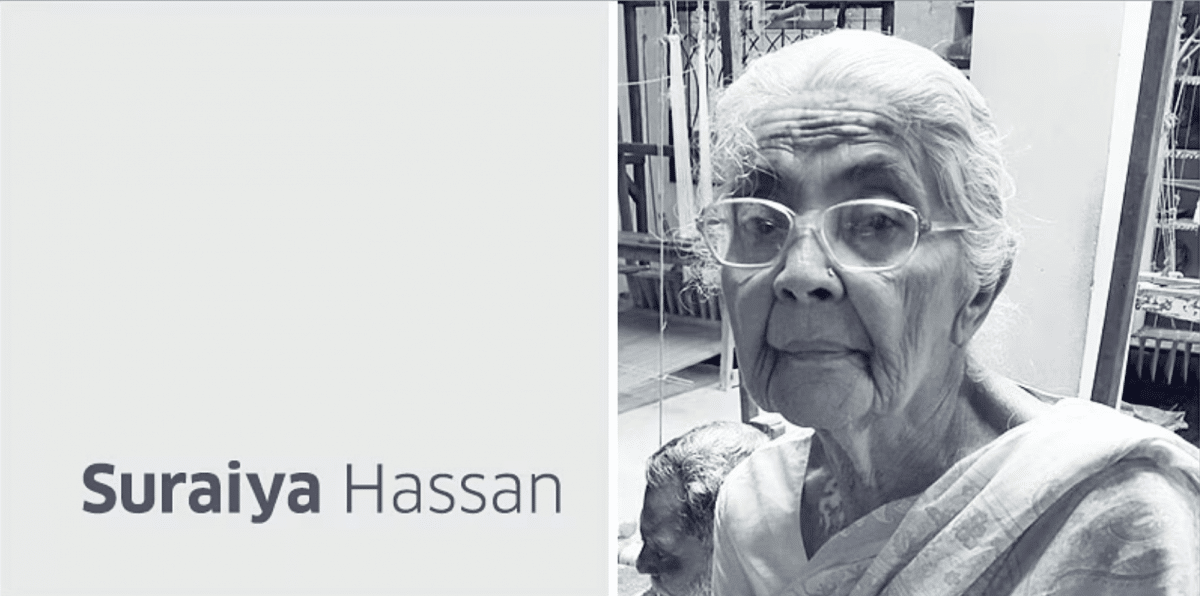If ever you visit Fab India (a popular store for traditional Indian clothing) you might chance upon a fat book near the cash counter with an image of yarn on its cover: ‘Weaving a legacy: Suraiya Hasan Bose’ by Radhika Singh. Spare a minute and thumb through the book about the life of India’s beloved fabric revivalist.
I was fortunate to meet Suraiya Apa several times. Any buyer who has ever visited ‘Suraiya’s Traditional Weaves and Crafts’ in Hyderabad will testify to Apa’s genial, unassuming presence and her cousin Dominic Hasan’s enthusiasm for fabrics.
I shifted to Hyderabad in 2012. Before that, we lived in Pune where, thanks to my office colleagues ( most of whom were women), I got introduced to the bountiful world of Indian weaves, fabrics, embroidery, and prints. Our lunch conversations would bubble forth about Bagh, Bagru, Ajrakh, Mangalgiri, Chanderi, Chikankari, Paithni, Ikat, kalamkari, and the rest. Each time one of us discovered a new fabric, weave, or print, she would share the images with the rest; all of us huddled around a PC with riveted attention
Hyderabad being the bastion of Ikat and Kalamkari, I was looking for an authentic place for Ikat and Kalamkari fabrics in the city. Fortunately, one day a friend took me to Suraiya Apa’s little shop in an old bungalow. The range of Kalamkaris and Ikat took my breath away. The highlight of the visit, however, remains our meeting with the ever-smiling, ever-friendly Suraiya Apa. Demonstrative in her affection, she gave us a warm hug and showed us the fabrics herself. With care, she opened each ream of fabric all the while talking about the place where it was produced. She talked a bit about her journey through the world of fabrics and her efforts to revive Himroo and Mushroo (Persian weaves). I began to frequent Apa’s shop, which was nothing short of a hermitage. During those visits, I gathered piecemeal information about her fascinating journey. Later, with the help of Bol Hyderabad (community radio station of the University of Hyderabad), we were able to record Apa’s interview. Imagine a young woman, barely out of her teenage, in an Indian Government textile shop at Oxford in the 1940s or early fifties explaining the nuances of Indian fabrics to the world! That’s just a small tidbit from Suraiya Apa’s life.
She was married into the Bose family (to Subhash Chandra Bose’s nephew, Aurbindo Bose) Her uncle, Abid Hussain Safrani served as a commander in the Azad Hind Fauj and is credited with the salutation ‘Jai Hind’. In the interview, I steered clear of too many personal details; I did not wish to dig into her personal life and wanted to focus on her amazing body of work instead. Here is the link to the interview. It is the only interview I have conducted in my life, so the glitches, the inconsistencies are all mine. Kindly ignore the same and listen to Suraiya Apa’s story. She passed away in September this year. I consider it my duty to tell her tale to as many people as I can. Here it is now for you now in her own voice.
https://www.youtube.com/watch?v=vsN79e0kXZs&t=1163s
Unbeknownst we wear fabrics with traditional prints and motifs (paisleys, geometric Ikat design, Ajrakh prints) which have been around—for the lack of exact historical dating— since the flood. By buying traditional Indian fabrics, we must actively become custodians of that rich tradition and heritage.









Comments & Discussion
20 COMMENTS
Please login to read members' comments and participate in the discussion.